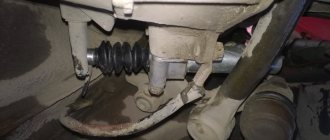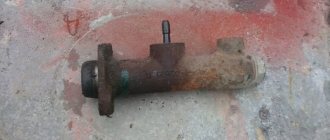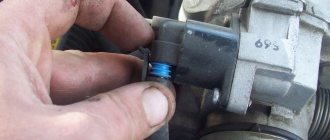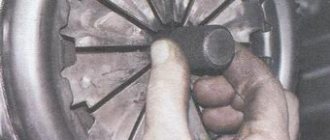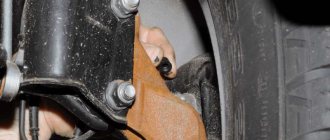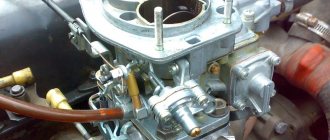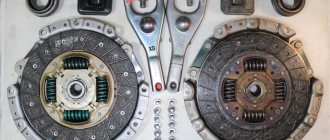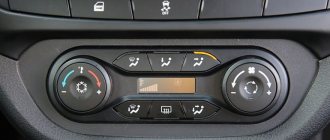This part in the clutch system plays a fairly important role as the final link in the distribution of hydraulic load. In the classic VAZ clutch system, the master cylinder is located, respectively, in the engine compartment near the gearbox and has a fairly convenient outlet for repairing the VAZ 2106 clutch slave cylinder. The part consists of several main parts, which together form a single small but important unit:
- The piston directly serves to squeeze out the fluid located in the main tank (as usual, special brake fluid is poured there). When the clutch pedal is pressed, it is the piston that activates the hydraulic pressure mechanism and applies forceful pressure to the fork in the clutch.
- The case is the fundamental part in which the entire mechanism is enclosed. The outer part in modern versions is made of durable plastic. In early models on old Soviet designs, a metal body is sometimes found, but this design is less reliable not only due to age, but also due to the likelihood of corrosion.
- The rod is driven by a piston and acts as a pusher both when the pedal is pressed and after it is released. When pressed, this part pushes liquid into the system, and then closes the housing for liquid.
- The protective cap serves to maintain integrity inside the system when liquid enters. Otherwise, it is simply called a cover that covers the housing parts from excessive contact of substances with the mechanical parts of the unit.
- The spring acts as a single unit together with the piston when the gas pedal is pressed and actually “serves” the unit during the return action. One of the main reasons for system failure is often the wear of the spring, which causes the cylinder to not close properly and the fluid to escape beyond the closed circuit.
- A valve for bleeding air, which is also a common cause of failure of the entire part due to its inoperability. This part is designed to remove excess air during piston operation. Excess air, if present in the system and liquid penetrating inside, leads to the disappearance of the clutch, which can lead to an emergency. It is the valve that serves to remove the formed air, but for some reasons this unit can wear out and fail. Moreover, despite its simple design, such a part can rarely be repaired and most often must be completely replaced, not only because of the impossibility of the repair itself, but mostly because of the low cost of both the complete assembly and its individual parts.
Installing the clutch master cylinder repair kit
It is not difficult to determine when it is necessary to repair the master cylinder; the main signs of its malfunction are:
- Insufficient clutch release (clutch drives)
- Any type of leakage, whether from under the nuts securing the hose and tubes, or from the end from under the rubber seals
- Master cylinder stuck in pressed position
In my situation, the main leak was due to a worn out sealing ring, in other words, fluid flowed down the clutch pedal into the passenger compartment.
I started the repair by dismantling the reservoir hose, unscrewed the clamp on the main cylinder and quickly removed it from the main cylinder, turned it up and pinched it behind the reservoir cap so that the liquid did not flow out of the reservoir. Next, I unscrewed the tube that goes to the working cylinder, I did this with a special key, it’s a pity there is no photo, but you can buy one without any problems at any auto store. All that remains is to unscrew the main one itself, it is secured with two 13 nuts and remove it from under the hood.
The boot was removed and it was noticeable that fluid was flowing from here.
Having picked up the boot with a screwdriver, I saw exactly where the liquid was flowing from; the assumption was absolutely correct.
Next, you need to wipe the cylinder, remove dirt and rust.
Attention. Do not use gasoline or similar liquids for washing, as they will very quickly ruin the new rubber bands. To flush the clutch and brake elements, use clean brake fluid.
After cleaning the dirt, you can begin disassembling. To do this you will need an awl or similar object.
Next, you need to carefully remove the insides, keeping in mind that the piston is under the action of a spring.
This is what it looks like
Next, you need to clean the master cylinder body, you cannot scrape the parts with a screwdriver, sandpaper, etc., this is just in case, I use a rag with brake fluid. In repair manuals, I often came across such expressions that if rips, scratches, etc. appeared on the parts, then it is unusable. But despite all this, practice shows that despite all the risks, provided that a high-quality repair kit is installed, the master cylinder works without problems. I used this kit:
Repair kit for clutch master cylinder VAZ
We remove the old rings, clean all the grooves and holes. There should be no dust or debris there.
The ring is removed, clean the piston, install a new one
Thanks for subscribing!
And by the way, here is the reason for the clutch cylinder leaking:
The ring is not worn evenly
After cleaning and replacing the rings, you can assemble the cylinder, below is a photo of what should be there and how:
Here is a photo not cleaned, I added it here to show the correct assembly
Having assembled the cylinder, install the corkscrew ring
Bleeding the clutch on a VAZ 2106
After the repair has been made, it is necessary to bleed the clutch. In all repair manuals you can find standard instructions for bleeding the clutch, but it may not always help.
- The first bleeding option is standard; it consists of filling the tank with liquid, unscrewing the bleeding fitting, putting a hose on the fitting, and lowering the other end into a container with clean liquid. Then, by pressing the pedal, we monitor when the air stops being released, and also do not forget to control the level in the tank.
- The second method is to use an assistant - one person presses the pedal 4-6 times and keeps it pressed to the floor. The second unscrews the bleeder fitting; air bubbles should come out of the fitting; as soon as they stop coming out, you need to screw the fitting in and then release the pedal. And so on until normal operation of the pedal is restored and air bubbles stop coming out.
- There is also the simplest method of pumping, but which does not always work - to implement it you just need to pour liquid into the reservoir and unscrew the fitting on the working cylinder. The liquid will flow by gravity through the entire system and when it begins to flow steadily out of the fitting, it can be closed and the pumping can be considered complete.
Why do you need to change the clutch?
To replace the clutch you will need to stock up on: A 13mm wrench, and in addition to all this you will also need to take two different types of screwdrivers (Flat and Phillips in this case), and you also need to stock up on a mandrel for centering the clutch disc which in a car store it costs literally 100 rubles! (You can see what this mandrel looks like, which is discussed in the article, just below in the section: “For beginners!”)
When should you change the clutch?
During operation, the clutch of any car wears out over time, and the first signs of a worn clutch that a car will show are:
- Increased noise that begins to appear very clearly when changing gears in the car.
- Jerks can also occur when starting a car, and they can also occur while driving when you depress the clutch pedal, then engage a gear, and then when you release the pedal, the car jerks forward slightly.
- In addition to all this, if the clutch malfunctions, the effect that the clutch “slips” may occur. This is when you are driving a car and at the same time you press the gas pedal, let’s say to the floor, and your car does not accelerate, but the engine speed increases sharply and even reaches the red zone, this effect is popularly called the clutch “Slipping”.
- And in conclusion, we note one more effect, called the “Leads” clutch. The first signs of this effect are as follows: let’s say you engage first gear and at this time the clutch pedal is still fully depressed, but even despite this the car starts to roll. This effect is called the “Leads” clutch.
Product location
The master cylinder on a VAZ 2107 is located under the hood, directly on the wall separating the interior from the hood, near the driver’s feet. Directly above it is the expansion tank, and next to it are the vacuum booster and the brake master cylinder. Usually, simply looking at the product is enough to determine the problem. The presence of a leak indicates that the part is faulty and requires repair or replacement.
Purpose of the device
Cars are equipped with clutch master and slave cylinders, without which the operation of the mechanism is impossible. The VAZ 2107 clutch master cylinder is designed to push out brake fluid. Below is a diagram from which you can visually find out the operating features of the unit.
When you press the clutch pedal, the piston moves in the device in question, thereby pushing out the brake fluid. This liquid enters the working cylinder through a tube, where the reverse process is observed (the liquid pushes out the piston). Brake fluid drives a piston, which is connected by a fork to the clutch disc. As a result, the clutch disc and flywheel are separated, allowing you to change gear. The GCS is also called the main one, since it is with its help that force is supplied from the pedal when it is pressed.
The need to replace the device: when required
Like all parts of any car, the GVC tends to wear out, resulting in the need for repair or replacement. The simplest breakdown of a product is wear of the boot, which can be determined by the characteristic signs of a fluid leak.
To identify a cylinder malfunction, an initial visual inspection is required. It is possible to repair a failed main circulation system on a VAZ 2107; for this you can look for repair kits, but this is not always rational due to the quality of modern spare parts, so it is easier and faster to replace it entirely. The malfunction can also be determined by the characteristic loss of pressure in the system, which is determined by pressing the pedal. Let’s take a closer look at how to change a faulty VAZ 2107 mechanism.
We change it ourselves
Replacing the VAZ 2107 clutch master cylinder begins with the need to pump out the brake fluid from the hydraulic reservoir. This can be done using a syringe or a rubber bulb. Together with this socket or a 10mm wrench, unscrew the bracket securing the expansion tank and move it to the side to gain access to the cylinder.
The next step involves removing the clutch expansion tank hose. To do this, you need to loosen the hose clamp, then disconnect the hose and position it so that it does not interfere with further work. If you want to remove the tank completely, this is done very simply.
Further actions are performed in the following sequence:
- Using a “10” wrench, you need to unscrew the pipeline securing nut to the device. Once the nut is unscrewed, the tube can be moved to the side.
- There is a hose nearby near the steel pipeline, which also needs to be disconnected from the main device. This can be done by loosening the fixing clamp.
- The GCS is fixed to the body using two fastening nuts. To unscrew them, you will need to use a wrench with an extension and a “13” socket. After unscrewing the two nuts, you can remove the product and drain the remaining brake fluid from it. If it is not possible to dismantle the unit, you can press the clutch pedal, as a result of which it will move.
- But repairs are usually not rational, so after removing the old one, a new unit is installed in its place. Installation is carried out in the reverse order of removal. After installation, it is necessary to carry out the process of pumping the hydraulic drive, first pouring fuel fluid into the tank. You can find out how the system is pumped from the relevant material on the website.
How to repair a VAZ hydraulic drive
The main thing to remember is that in all cases of such repairs, after it has been carried out, it will most likely be necessary to pump the hydraulic system. It must be done according to the instructions for this car model.
So, to replace the clutch master cylinder in a VAZ 2107 we will need:
- wrenches;
- syringe, container;
- screwdriver, pliers.
- Use a syringe to pump out the fluid from the master cylinder reservoir.
- Having loosened the clamp, pull the tube off the tank and drain the liquid from it into a substitute container.
- We unscrew the fastenings of the pipe connecting the first and second hydraulic drive units.
- By pressing the pedal, we remove the broken link of the system.
- We install the new spare part in the reverse order.
- Add the missing liquid to the reservoir.
Changing the master cylinder of a VAZ 2106 is carried out in the same way. But the work of replacing the working cylinder of a VAZ 2107 will have to be carried out using a slightly different method. True, we’ll take the same tools.
VAZ cars: repair, maintenance, tuning
Failures in the clutch operation of the classic VAZ 2107 - VAZ 2101 must be eliminated immediately. The clutch hydraulic drive system is not too complicated, maintenance work does not take much time, so removing, disassembling and repairing the VAZ clutch master cylinder will not be difficult even for novice drivers. Let’s find out how to deal with problems in the VAZ clutch right now.
Major breakdowns
Despite the high cost of the design, the VAZ-2106 clutch breaks quite often. The clutch cylinder fails and leaks appear. This happens for the following reasons:
- Excessive wear on the slave and master cylinder parts.
- Using brake fluid not recommended by the vehicle manufacturer.
- A decrease in the liquid level in the expansion tank due to its damage or loosening of the pipe clamps.
The price of the VAZ-2106 clutch master cylinder is 400-600 rubles, depending on the manufacturer. But you can also find more expensive parts. The repair kit is a little cheaper - about 300 rubles.
Clutch drive device VAZ 2107
We dealt with the clutch mechanism of the classic VAZ 2101-2107 not so long ago. There is nothing complicated there either and you can refresh your knowledge here. In all rear-wheel drive VAZ cars, the clutch release drive is hydraulic. The clutch master cylinder is installed in the engine compartment on the shield, the cylinder is located coaxially with the clutch pedal rod. A pusher is attached to the pedal itself through a hinge, which presses directly on the master cylinder piston. The VAZ clutch drive diagram is presented below.
Clutch drive diagram VAZ 2101-2107
Thus, the rod, through the pusher piston, acts on the incompressible brake fluid in the master cylinder, which transmits force to the piston of the working cylinder, already installed on the gearbox housing through the hydraulic hoses.
What is needed for repair?
If the master or slave cylinder has become unusable, you will need to make repairs. On sale you can find special kits consisting of pistons, sealing rings, and springs. But installing them on old worn-out cylinders is unlikely to be advisable. Pistons and rings have standard sizes, but the inner surface of the cylinder wears out over the years, and in most cases this happens unevenly.
Therefore, when installing new, almost perfect pistons, you will not get the desired effect. When making repairs, you must purchase brake fluid. In general, its resource is no more than two years. Only in this case will the liquid work as efficiently as possible; if this period is exceeded, the additives that are added to the liquid will volatilize.
Before starting repairs, be sure to drain all fluid from the system. To do this, you need to pump it out of the expansion tank using a bulb. Then, unscrew the bleeder fitting on the working cylinder and get rid of the residue.
Malfunctions of the VAZ 2107 clutch master cylinder
Like any mechanism, the master cylinder is subject to wear, which reduces the efficiency of the system as a whole. The main malfunctions of the cylinder are fluid leaks or loss of nominal dimensions of the cylinder mirror, piston, wear of cuffs and seals. This is expressed in incomplete disengagement of the clutch, the pedal may fall through or be too tight. At the first suspicion of the clutch drive, we perform an initial diagnosis of the system:
- Check the fluid level in the clutch reservoir. A level that is too low indicates a brake fluid leak.
- Inspect the master cylinder for leaks. It should be taken into account that it can leak both in the area of the hydraulic drive fitting, the plug gasket, and in the area of the protective cap, which faces towards the pedal. In this case, the liquid will penetrate into the interior under the carpet and the leak may not be noticed immediately.
In this case, the leak was caused by wear of the piston cuff; fluid flowed into the passenger compartment. - If the clutch starts to engage only after a few presses of the pedal, then most likely air has entered the drive system. In this case, it is necessary to find out the cause of airing (loss of tightness, leak of the main or working cylinder), and only then perform bleeding and removal of air from the hydraulic system.
Pedal dips
A dip in the pedal is one of the main signs that the VAZ-2106 clutch mechanism has become unusable. The clutch master cylinder may have lost its seal. But you shouldn’t blame it right away; you need to carefully examine all the elements of the system. The pipes connecting the cylinders must not have brake fluid leaks. There should also be no traces of it on the cylinder bodies themselves. If the pedal fails, the clutch will not work normally.
The following problems may occur:
- Difficulty changing gears.
- Drop in fluid level in the expansion tank.
- When used for a long time in this mode, the release bearing, basket, and disk fail.
If you notice a pedal failing, try to carry out repairs as quickly as possible, since with each press the fluid will come out of the system.
How to check the VAZ clutch cylinder, free play adjustment
In order not to do unnecessary work, it is better to spend half an hour and conduct independent diagnostics of the clutch drive. To do this, it is enough to place the car on a flat surface, it is advisable to have access to the gearbox housing from below (pit, overpass). Next, we check the operation of the system in this order:
- From inside, we check the free play of the clutch pedal. The nominal free play is from 0.4 to 2 mm. If adjustment is necessary, take a 10mm open-end wrench and loosen the lock nut of the limiter A in the photo below, setting the free play.
- We go down under the car and check the free play of the working cylinder pusher. Before doing this, it is advisable to apply WD-40 penetrating lubricant to it. To do this, press the pusher fork back with your fingers; the free play should be within 5 mm.
- To adjust the free stroke of the rod, use keys 13 and 17 to loosen the locknut.
- Using a 8mm wrench we hold the rod, and using a 17mm nut we achieve such a rod length that the free play is within 5mm.
- Tighten the locknut, go to the salon and check the free play of the pedal until the clutch disengages, which should be within 30 mm. If necessary, add brake fluid to the reservoir.
Removing and installing the clutch on a VAZ 2106 car
The main malfunctions, the elimination of which requires removal and disassembly of the clutch: - increased (compared to usual) noise when the clutch is engaged; — jerks when the clutch operates; — incomplete engagement of the clutch (the clutch “slips”); — incomplete disengagement of the clutch (the clutch “drives”).
USEFUL TIPS The work of removing and installing the clutch is very labor-intensive, so first make sure that the malfunctions are not caused by defects in the clutch drive. If, after disassembling the clutch, no obvious signs of malfunction of individual components are found, replace all components at the same time. Since before removing the clutch it is necessary to remove the VAZ 2106 from the car, work with an assistant.
To remove the clutch from a VAZ 2106 car you will need: a 13mm wrench, two screwdrivers, a mandrel for centering the driven disk (can be made from the input shaft of the gearbox by removing the gear).
2. Install the mandrel to center the clutch driven disc so that its front part is completely seated in the bearing pressed into the end of the crankshaft.
3. Screw bolt 2 into place of the lower left bolt securing the clutch housing to the cylinder block. Remove the six bolts securing the pressure plate to the flywheel, holding flywheel 1 from turning with a screwdriver and remove the pressure plate.
WARNING When removing bolts, hold the clutch housing with your hand. Do not hold it by the pressure spring stop flange.
4. Remove the clutch driven disc together with the mandrel and remove the mandrel from the driven disc hub. 5. Install the clutch on the VAZ 2106 car in the reverse order of removal.
NOTE: Before tightening the clutch pressure plate bolts, carefully center the clutch drive plate using a tool. If this is not done, installation of the gearbox will be difficult.
How to remove the clutch master cylinder VAZ 2107 - 2101
During operation, rubber parts and the piston most often wear out, and after 200 thousand mileage it is necessary to carefully check the cylinder mirror.
VAZ master cylinder mirror with signs of wear
In order to remove the VAZ clutch master cylinder, you must first drain the brake fluid from the system. To do this, first of all, we put the hose on fitting 9 of the working cylinder (photo below), and lower the second end of the hose into a clean vessel.
Slave cylinder and clutch release fork: 1-clutch release bearing; 2-ball joint; 3-clutch release fork; 4-pusher; 5-adjusting nut; 6-lock nut; 7-tension spring; 8-body plug; 9-fitting for bleeding; 10-cylinder body; 11-o-ring; 12-wire cap; 13-piston; 14-seal; 15-plate; 16-spring; 17-support washer; 18 circlip
After this, unscrew fitting 9 half a turn and press the clutch pedal until all the liquid goes into the container. Screw in the fitting and remove the tube. If you need to remove the working cylinder (obvious leak, damage to the boot), remove spring 7, the cotter pin from the end of the pushers and unscrew the two mounting screws. To remove the master cylinder, simply disconnect it from the expansion tank and unscrew the two fastening nuts, as shown in the photo below. Remove the cylinder by unscrewing the hydraulic drive fitting.
Checking and replacing the hose on the clutch cylinder
The hose on the clutch slave cylinder is an extremely critical part that is exposed to high brake fluid pressure. Therefore, the car owner must monitor its condition especially carefully.
The clutch cylinder hose is a very important part, the condition of which must be carefully monitored
Here are signs that indicate that the hose should be changed urgently:
- cracks and other mechanical damage visible to the naked eye have appeared on the hose;
- the hose looks intact, but there are visible leaks of brake fluid on it (this means that it is still damaged and microcracks have appeared on it, which the driver simply cannot see);
- The threads on the hose ends are partially or completely stripped.
If you notice any of the above, the hose should be replaced immediately. It is better to install standard VAZ clutch hoses, their catalog number is 2101–16–025–90, and the cost is about 80 rubles.
Hose replacement sequence
Before starting work, you should stock up on an empty plastic bottle and two open-end wrenches: 17 and 14 mm.
- The car is driven into the pit and secured with wheel chocks. Open the hood and find the place where the slave cylinder hose is screwed to the clutch hydraulic tube.
- The main hose nut is held firmly with a 17 mm wrench, and the fitting on the hydraulic tube is unscrewed with a second wrench - 14 mm. After unscrewing the fitting, brake fluid will flow out of it. Therefore, there should be a container in the inspection hole to collect it (a small basin would be the best option).
- The second end of the hose is unscrewed from the working cylinder body using the same 17 mm wrench. There is a thin O-ring in the cylinder under the hose nut, which is very often lost when removing the hose . This ring should also be changed (as a rule, new seals come with new clutch hoses).
- A new hose is installed in place of the old one, after which a new portion of brake fluid is added to the hydraulic system.
So, even a novice driver can change the working cylinder on a six. All you need to do for this is to carefully prepare the necessary tools and strictly follow the above recommendations.
The clutch mechanism of a vehicle is one of the most important automotive units, which ensures the immediate function of the propulsion mechanism - translational movement along and against the direction of travel of the vehicle. Without interaction with this mechanical-hydraulic unit, using the car is not possible.
Repair of clutch master cylinder VAZ 2107
After dismantling the master cylinder, carefully wipe it from any remaining liquid and dirt and clamp it in a vice for disassembly.
First, let's estimate from the diagram which parts of the cylinder will need to be replaced.
Master cylinder parts: 1-body; 2-lock washer; 3-fitting; 4-gasket; 5-cap; 6-stop ring; 7-piston pusher; 8-o-ring; 9-piston of the main cylinder; 10-spring
First of all, after disassembly, we check the condition of the cylinder mirror. If the internal diameter is larger than the nominal 19.05 mm, there are obvious deep scratches and stepped wear on the mirror, repair does not make sense. You'll have to buy a new cylinder. If everything is fine with the mirror, we proceed to inspect the piston return spring. If it has lost its elasticity, we only change it. Next, using a standard repair kit, we replace all seals 8 and boot 5.
Complete repair kit for clutch master cylinder VAZ 2107
After replacing worn parts, we thoroughly rinse the entire cylinder and each part with fresh brake fluid, only then reassemble it according to the diagram.
Repair
In order to repair the clutch cylinder, it must be removed from the VAZ 2106. This is done using a 8-mm wrench. Next, secure the part in a vice and release the air from it by unscrewing the special fitting.
Removing the protective boot
The next step is to rotate the part 90 degrees without removing it from the vice. Remove the protective cap, and then the pusher located under it. Next, use a screwdriver to pull out the piston. There will be a spring and a support ring on it. They also need to be removed.
Once the spring and ring are removed, remove the rings. Now that all the parts of the clutch slave cylinder have been removed, they need to be cleaned with gasoline and wiped dry with a rag. Next, reassemble all the parts in reverse order and test it in action. If the symptoms recur, repair will no longer help and a complete replacement of the part will be required. After this, your VAZ 2106 will definitely get a second life, and the problems with the cylinder will disappear.
Which clutch master cylinder is better to install on a VAZ 2107, articles and prices
To completely replace the VAZ 2107 - VAZ 2101 clutch master cylinder, analogues from other cars are not suitable. Fortunately, there are more than enough original cylinders and analogues on sale. As a rule, the public tries to choose a branded VAZ cylinder with catalog number 2101-1602610 . Other manufacturers also use this article, but when purchasing, it is better to start not so much from the price of the cylinder, but from the level of trust in the brand. A branded master cylinder will cost us 8-9 dollars and this is one of the most expensive options.
Next, you can choose from what is on the counter:
- The DK cylinder is half the price of the branded one, but often leaks due to poor-quality plug gaskets. As a temporary option, it will do.
- BAZALT , price about 200 hryvnia (about 7 dollars), Basalt and Phenox are highly not recommended due to the disgusting quality of mirror polishing.
- Excellent German Metelli , price approximately equal to the original one, factory article number 55-0014G .
- German ATE, HORT do not cause any complaints, the price is around 10 dollars.
- There are a lot of Chinese cylinders, like AT 2610-001H , the price is about 6 dollars, the quality is unstable.
Instability in China
Upon completion of the master cylinder repair work, fill in DOT4 brake fluid from any manufacturer and bleed the clutch drive in the same way as bleeding air from the brake system.
Replacing the working cylinder
This is the mechanism that is installed on the clutch housing of the VAZ-2106. The clutch master cylinder is mounted opposite the pedal. Sequencing:
- Remove the retainer from the pusher.
- Remove the return spring.
- Carefully unscrew the nut located on the liquid hose.
- Drain the remaining brake fluid by unscrewing the hose.
- Remove the two bolts that secure the cylinder. The pushrod must be pulled out from the clutch fork.
When removing, it is necessary to install a rubber gasket with a washer on the new hose. It is not included in the repair kit. Assembly is carried out in reverse order. Using a nut located on the rod, the travel of the clutch pedal is adjusted. But this should be done only after pumping.
